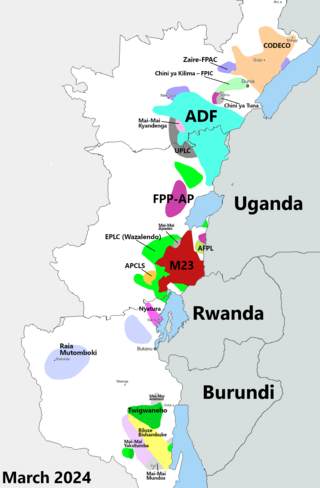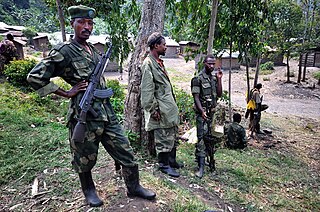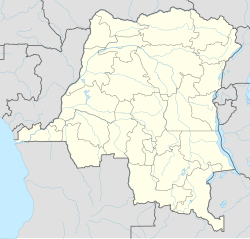
North Kivu is a province bordering Lake Kivu in the eastern Democratic Republic of the Congo. Its capital is Goma.

Goma is the capital of North Kivu province in the eastern Democratic Republic of the Congo. It is located on the northern shore of Lake Kivu, next to the Rwandan city of Gisenyi. The lake and the two cities are in the Albertine Rift, the western branch of the East African Rift system. Goma lies only 13–18 km (8.1–11.2 mi) south of the active Nyiragongo Volcano. The recent history of Goma has been dominated by the volcano and the Rwandan genocide of 1994, which in turn fuelled the First and Second Congo Wars. The aftermath of these events was still having effects on the city and its surroundings in 2010. The city was captured by rebels of the March 23 Movement during the M23 rebellion in late 2012, but it has since been retaken by government forces.

Julien Paluku Kahongya is a Congolese politician. He served as the governor of the province of North Kivu from 27 January 2007 to 22 February 2019.

The Kivu conflict began in 2004 in the eastern Congo as an armed conflict between the military of the Democratic Republic of the Congo (FARDC) and the Hutu Power group Democratic Forces for the Liberation of Rwanda (FDLR) in the Democratic Republic of the Congo. It has broadly consisted of three phases, the third of which is an ongoing conflict. Prior to March 2009, the main combatant group against the FARDC was the National Congress for the Defence of the People (CNDP). Following the cessation of hostilities between these two forces, rebel Tutsi forces, formerly under the command of Laurent Nkunda, became the dominant opposition to the government forces.

Rutshuru Territory is a territory in the North Kivu province of the eastern Democratic Republic of the Congo (DRC), with headquarters is the town of Rutshuru.

The March 23 Movement, often abbreviated as M23 and also known as the Congolese Revolutionary Army, is a rebel military group that is for the most part formed of ethnic Tutsi. Based in eastern areas of the Democratic Republic of the Congo (DRC), it operates mainly in the province of North Kivu. The M23 rebellion of 2012 to 2013 against the DRC government led to the displacement of large numbers of people. On 20 November 2012, M23 took control of Goma, a provincial capital with a population of a million people, but it was requested to evacuate it by the International Conference on the Great Lakes Region because the DRC government had finally agreed to negotiate. In late 2012, Congolese troops, along with UN troops, retook control of Goma, and M23 announced a ceasefire and said that it wanted to resume peace talks.
The Alliance of Patriots for a Free and Sovereign Congo is an armed militia group which operates in the north-east of the Democratic Republic of the Congo. APCLS is traditionally active in Masisi Territory, North Kivu and is considered one of the largest mai-mai groups operating in the province. Formed in 2006, the APCLS draws most of its support from the Hunde ethnic group. Its ideology is founded on opposition to the Tutsi ethnic groups who are believed to threaten the integrity of the Congolese state and to be supported, in particular, by Rwanda. The APCLS is a belligerent in the ongoing Kivu conflict and is led by Janvier Buingo Karairi, known as General Janvier.

The Allied Democratic Forces insurgency is an ongoing conflict waged by the Allied Democratic Forces in Uganda and the Democratic Republic of the Congo, against the governments of those two countries and the MONUSCO. The insurgency began in 1996, intensifying in 2013, resulting in hundreds of deaths. The ADF is known to currently control a number of hidden camps which are home to about 2,000 people; in these camps, the ADF operates as a proto-state with "an internal security service, a prison, health clinics, and an orphanage" as well as schools for boys and girls.
The 2020 Democratic Republic of the Congo attacks were a series of attacks which took place in 2020. The attacks were mostly carried out by the Allied Democratic Forces (ADF), a radical Islamist rebel group and the Cooperative for the Development of Congo (CODECO), an agricultural and religious group made up of ethnic Lendu people. The attacks left at least 1,316 people dead and 132 injured.
This a timeline of the Kivu conflict during 2020.
Attacks were carried out by various armed groups in the Democratic Republic of the Congo in 2021 and 2022. The attacks have killed 629 and injured 321. At least 82 perpetrators were also killed and one injured in these attacks.
Events in the year 2021 in the Republic of the Congo.

Mamadou Mustafa Ndala was a colonel in the Armed Forces of the Democratic Republic of the Congo.

In late March 2022, the March 23 Movement (M23) launched an offensive in North Kivu, clashing with the Armed Forces of the Democratic Republic of the Congo (FARDC) and MONUSCO. The fighting displaced tens of thousands of civilians and caused renewed tensions between the Democratic Republic of the Congo and Rwanda, as the latter was accused of supporting the rebel offensive.
Yusufu Eric Mboneza, more commonly called Yusuf Mboneza, is or was a Congolese military officer and rebel. During his career he served in the Rally for Congolese Democracy, the National Congress for the Defence of the People, the Armed Forces of the Democratic Republic of the Congo, and finally the March 23 Movement.

In late July 2022, anti-MONUSCO protests manifested in the Democratic Republic of the Congo. The protests were against MONUSCO, the United Nations' peacekeeping force in the country, which has been accused by Congolese politicians and civilians of failing to take action to end the decades-old conflict within the country. The protestors demanded that MONUSCO leave the country.

The Rubaya mines, also known as the Bibatama Mining Concession, is a series of coltan mining sites near the town of Rubaya in Masisi Territory, North Kivu, Democratic Republic of the Congo. Officially, the mining license is held by Société Minière de Bisunzu Sarl (SMB), associated with Congolese senator Edouard Mwangachuchu. Specific sites include Bibatama D2, Luwowo, Gakombe D4, Koyi, Mataba D2, Bundjali, and Bibatama D3.

Lemera is a locality in the northwest of Uvira in the South Kivu province, in the Democratic Republic of Congo. It is located 60 kilometers north of Bukavu, 90 kilometers southwest of the Rwandan and Burundian border. Lemera is situated nearby to the villages of Kasheke, Nyambasha, Luzira, Lukayo, Kajuju, Lushasha and Ihusi.

The Kishishe massacre occurred on from November 29 to December 1, 2022, in the North Kivu village of Kishishe in the Rutchuru Territory in the eastern Democratic Republic of the Congo. The March 23 Movement, a predominantly Tutsi armed group, summarily killed at least 131 civilians in Kishishe following clashes with local militias, according to a preliminary United Nations investigation. At the same time, the Kinshasa authorities had mentioned approximately 300 dead in the massacre. More than hundreds of thousands of people were displaced to other locations, such as, Kanyabayonga, Kibirizi, Kashala, Kirima, Nyanzale, Kashalira, Bambu and Kitchanga, or taken refuge in neighboring countries.
Kinyandonyi is a village in the Rutshuru Territory of the North Kivu province, Democratic Republic of the Congo. Kinyandonyi is situated 10 km east of the city of Kiwanja in Bukoma groupement, in the Bwisha Chiefdom and 85 km north of the capital of the province Goma. The region is inhabited by the Hunde people as well as some remaining autochthonous populations of African Pygmies, including the Twa people and the Mbuti people. In addition to the Hunde, Twa, and Mbuti, there are other ethnic groups, including the Nyanga, Lega, Kumu, Hutu and Tutsi.
















